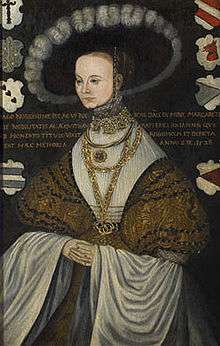Margareta Eriksdotter Vasa


Margareta Eriksdotter Vasa (1497 – 31 December 1536), also called Margareta Vasa and Margareta of Hoya, was a Swedish noblewoman, sister of king Gustav I of Sweden.
Life
Margareta was born to Erik Johansson Vasa and Cecilia Månsdotter. She was married to Joakim Brahe on 30 March 1516. In 1520, her husband and father were executed at the Stockholm Bloodbath. Margareta, as well as her mother, her sisters and her grandmother, were among the women taken prisoner to Denmark with the former regent, her aunt Christina Gyllenstierna, and was impriosoned in the feared Blue Tower in Copenhagen. There, several of them, among them Margareta's mother and sisters, died of the plague.
In 1524, Margareta was released and returned to Sweden, where her brother was now king. On 15 January 1525, she married the German count John VII of Hoya and Brockenhusen. She had also inherited the estate Rydboholm Castle after her father. In 1528, she visited Germany and Lübeck. After he return to Sweden in April 1529, she and Wulf Gyl were captured by mayor Nils Arvidsson of Jönköping. This incident was the beginning of the Westrogothian rebellion of the nobility against the ongoing Swedish Reformation. The rebellion was successfully subdued by her brother in May, and she was released unharmed.
Margareta and her husband eventually came at odds with the king. The queen, Catherine of Saxe-Lauenburg, is said to have slandered the king before them. In 1534, they broke with the king and left for Germany.
Margareta became a widow in 1535, when her husband died after having participated in the so-called Count's Feud in Denmark. She did not return to Sweden, as she feared that her brother would hurt her children. The king wrote several letters and asked her to return. She died in Tallinn in Estonia.
Family
Marriages and children:
- Joakim Brahe (died 1520 in the Stockholm Bloodbath)
- Per Brahe (1520–1590)
- John VII of Hoya (died 1535 in the Count's Feud on Funen, Denmark)
- John (1529–1574), bishop of Osnabrück.
- Jobst, co-adjutor in Cologne. He was captured by Franz von Halle and died in prison.[1][2]
References
- Svenskt Biografiskt Lexikon (SBL), cd-skiva, band 19
- Lars-Olof Larsson, Gustav Vasa - landsfader eller tyrann?
- Starbäck, Carl Georg (1868). Berättelser ur svenska historien. "bd 8". Stockholm: Abraham Bohlins boktryckeri. Libris 1583728
- Wilhelmina Stålberg (in Swedish) : Anteckningar om svenska qvinnor (Notes on Swedish women)